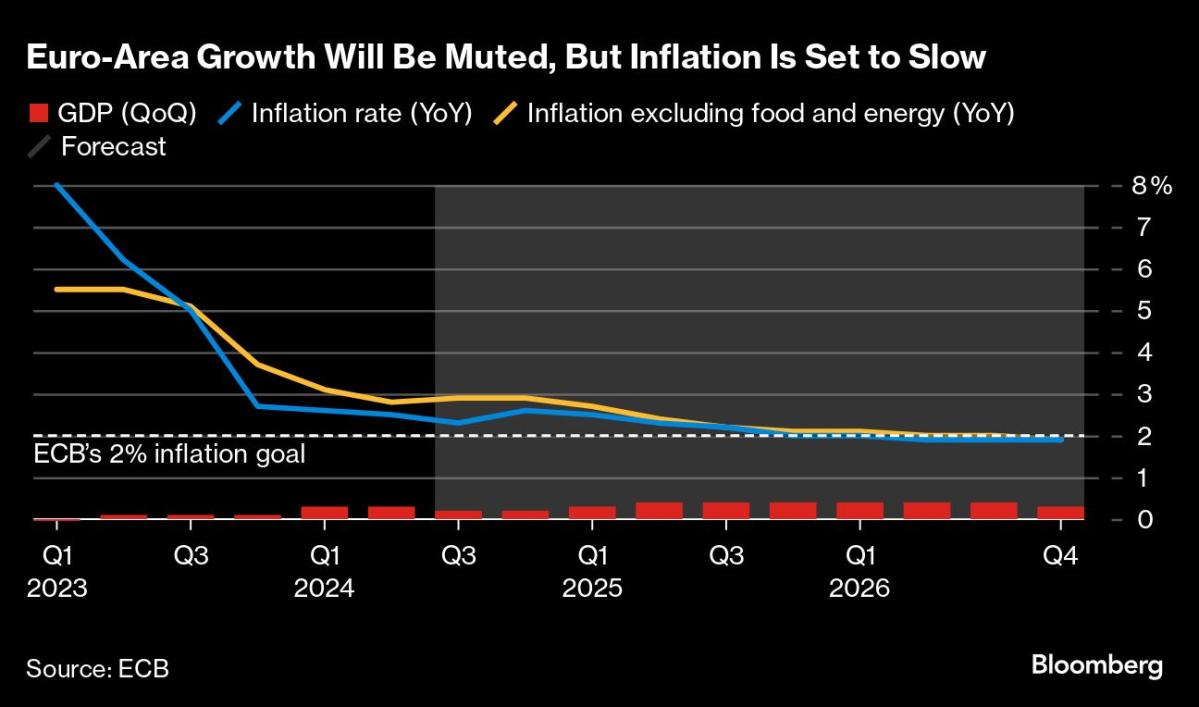


(Bloomberg) — The European Central Bank is open to considering an interest-rate cut in October if the economy suffers a major setback — though the next comprehensive set of information will only be available at the following meeting, President Christine Lagarde said.
Most Read from Bloomberg
Her remarks, less than a day after the ECB delivered its second quarter-point reduction in the deposit rate since June, offer the clearest signal yet that policymakers are leaning toward waiting until December for their next move.
But they’ve vowed to be data dependent and decline to rule out acting already next months. People familiar with their thinking have said it would take a more significant deterioration in the growth outlook or aggressive easing by the Federal Reserve to depart from the quarterly pace of rate-cutting.
“We have a lot of data at projections exercises, we also receive data in between,” Lagarde told reporters in Budapest, where she attended a meeting of euro-area finance chiefs. “We look at everything, and if there is a significant change relative to our baseline we reassess.”
ECB officials speaking before her on Friday have also been cautious in signaling any future steps.
France’s Francois Villeroy de Galhau said policymakers should continue to “gradually” lower rates.
“The pace has to be highly pragmatic,” he said. “We’re not pre-committing to any particular rate path, and we keep our full optionality for our next meetings.”
Officials, who first loosened policy in June, are responding to the latest retreat in inflation that took the rate within sight of their 2% goal. While some are wary of lingering price pressures in the services sector, others worry that the euro zone’s souring economy could lead to inflation undershooting the target as it did before the pandemic.
“The probability of a rate cut in October, if we look at the financial markets, isn’t big,” said Martins Kazaks of Latvia. “But at the same time, if there’s an unexpected hit to the economy, and if the economy feels significantly weaker than is currently expected and inflation also significantly declines, then of course we could also consider a rate cut.”
Markets see a chance of a move next month at just 25%.
In Lithuania, Gediminas Simkus said policymakers “will need strategic patience” as they plot the course ahead.
Inflation is “calming down” and “its trajectory suggests that further rate cuts must happen,” he told Radio LRT on Friday. “Rates will continue declining, but the speed of cuts will depend on data.”
For Austria’s Robert Holzmann, there could be “room” for another quarter-point move “in December,” suggesting there may not be sufficient additional data to decide on a step in October, according to an interview published by the Financial Times.
Luxembourg central-bank chief Gaston Reinesch said the ECB is likely to cut rates several times if its price outlook proves accurate.
Simkus cited services inflation as the “key uncertainty” — a danger that was also stressed by Slovenia’s Bostjan Vasle and Estonia’s Madis Muller.
There were some more positive assessments of price trends, with Bundesbank President Joachim Nagel describing the outlook as “very good.”
“We assume and the data back us up that we’ll reach our inflation target of 2% by the end of next year,” he told Deutschlandfunk. “The portfolio of data is such that it justified yesterday’s rate cut.”
But the quarterly forecasts underpinning those comments — also published Thursday — showed the economy is likely to expand less than previously envisaged in 2024, 2025 and 2026.
Indeed, after a brief early-year revival, Europe’s growth momentum is fading, with manufacturers still suffering from higher energy costs and soft demand beyond the 20-nation currency bloc. A long-promised consumer-led recovery is yet to materialize.
For some, the deteriorating backdrop is a reason to remain nimble.
Growth “remains slow in the euro area, and downside risks to growth have increased over the summer,” Finland’s Olli Rehn said. “We thus maintain full freedom of action and flexibility in making interest rate decisions in future meetings.”
Former ECB Chief Economist Peter Praet reckons the “best scenario” for the officials in Frankfurt is to cut in December. But factors such as a larger reduction in borrowing costs next week by the Fed could yet make October possible.
“December is far away, many things can happen,” he told Bloomberg Television’s Tom Mackenzie on Friday. “So the ECB tried to keep optionality.”
–With assistance from Milda Seputyte, William Horobin, Aaron Eglitis, Jan Bratanic, Ott Tammik and Leo Laikola.
(Updates with Reinesch in 14th paragraph.)
Most Read from Bloomberg Businessweek
©2024 Bloomberg L.P.